Molecular Characterization of the Viroporin Function of Foot-and-Mouth Disease Virus Nonstructural Protein 2B
- PMID: 30232178
- PMCID: PMC6232471
- DOI: 10.1128/JVI.01360-18
Molecular Characterization of the Viroporin Function of Foot-and-Mouth Disease Virus Nonstructural Protein 2B
Abstract
Nonstructural protein 2B of foot-and-mouth disease (FMD) virus (FMDV) is comprised of a small, hydrophobic, 154-amino-acid protein. Structure-function analyses demonstrated that FMDV 2B is an ion channel-forming protein. Infrared spectroscopy measurements using partially overlapping peptides that spanned regions between amino acids 28 and 147 demonstrated the adoption of helical conformations in two putative transmembrane regions between residues 60 and 78 and between residues 119 and 147 and a third transmembrane region between residues 79 and 106, adopting a mainly extended structure. Using synthetic peptides, ion channel activity measurements in planar lipid bilayers and imaging of single giant unilamellar vesicles (GUVs) revealed the existence of two sequences endowed with membrane-porating activity: one spanning FMDV 2B residues 55 to 82 and the other spanning the C-terminal region of 2B from residues 99 to 147. Mapping the latter sequence identified residues 119 to 147 as being responsible for the activity. Experiments to assess the degree of insertion of the synthetic peptides in bilayers and the inclination angle adopted by each peptide regarding the membrane plane normal confirm that residues 55 to 82 and 119 to 147 of 2B actively insert as transmembrane helices. Using reverse genetics, a panel of 13 FMD recombinant mutant viruses was designed, which harbored nonconservative as well as alanine substitutions in critical amino acid residues in the area between amino acid residues 28 and 147. Alterations to any of these structures interfered with pore channel activity and the capacity of the protein to permeabilize the endoplasmic reticulum (ER) to calcium and were lethal for virus replication. Thus, FMDV 2B emerges as the first member of the viroporin family containing two distinct pore domains.IMPORTANCE FMDV nonstructural protein 2B is able to insert itself into cellular membranes to form a pore. This pore allows the passage of ions and small molecules through the membrane. In this study, we were able to show that both current and small molecules are able to pass though the pore made by 2B. We also discovered for the first time a virus with a pore-forming protein that contains two independent functional pores. By making mutations in our infectious clone of FMDV, we determined that mutations in either pore resulted in nonviable virus. This suggests that both pore-forming functions are independently required during FMDV infection.
Keywords: 2B; FMD; FMDV; foot-and-mouth disease; viroporin.
Copyright © 2018 American Society for Microbiology.
Figures
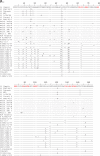

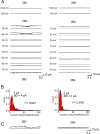
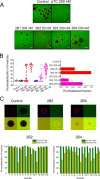
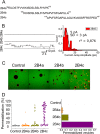

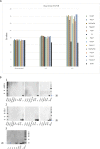
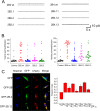


Similar articles
-
NLRP3 inflammasome activation by Foot-and-mouth disease virus infection mainly induced by viral RNA and non-structural protein 2B.RNA Biol. 2020 Mar;17(3):335-349. doi: 10.1080/15476286.2019.1700058. Epub 2019 Dec 15. RNA Biol. 2020. PMID: 31840571 Free PMC article.
-
Viroporin Activity of the Foot-and-Mouth Disease Virus Non-Structural 2B Protein.PLoS One. 2015 May 6;10(5):e0125828. doi: 10.1371/journal.pone.0125828. eCollection 2015. PLoS One. 2015. PMID: 25946195 Free PMC article.
-
Stearoyl coenzyme A desaturase 1 (SCD1) regulates foot-and-mouth disease virus replication by modulating host cell lipid metabolism and viral protein 2C-mediated replication complex formation.J Virol. 2024 Oct 22;98(10):e0090224. doi: 10.1128/jvi.00902-24. Epub 2024 Sep 26. J Virol. 2024. PMID: 39324793 Free PMC article.
-
Biological function of Foot-and-mouth disease virus non-structural proteins and non-coding elements.Virol J. 2016 Jun 22;13:107. doi: 10.1186/s12985-016-0561-z. Virol J. 2016. PMID: 27334704 Free PMC article. Review.
-
Membrane-active peptides derived from picornavirus 2B viroporin.Curr Protein Pept Sci. 2012 Nov;13(7):632-43. doi: 10.2174/138920312804142165. Curr Protein Pept Sci. 2012. PMID: 23131189 Review.
Cited by
-
Virulence and Immune Evasion Strategies of FMDV: Implications for Vaccine Design.Vaccines (Basel). 2024 Sep 19;12(9):1071. doi: 10.3390/vaccines12091071. Vaccines (Basel). 2024. PMID: 39340101 Free PMC article. Review.
-
Viroporin-like activity of the hairpin transmembrane domain of African swine fever virus B169L protein.J Virol. 2024 Aug 20;98(8):e0023124. doi: 10.1128/jvi.00231-24. Epub 2024 Jul 9. J Virol. 2024. PMID: 38980063 Free PMC article.
-
NLRP3 inflammasome activation by Foot-and-mouth disease virus infection mainly induced by viral RNA and non-structural protein 2B.RNA Biol. 2020 Mar;17(3):335-349. doi: 10.1080/15476286.2019.1700058. Epub 2019 Dec 15. RNA Biol. 2020. PMID: 31840571 Free PMC article.
-
Functions of Viroporins in the Viral Life Cycle and Their Regulation of Host Cell Responses.Front Immunol. 2022 Jun 2;13:890549. doi: 10.3389/fimmu.2022.890549. eCollection 2022. Front Immunol. 2022. PMID: 35720341 Free PMC article. Review.
-
Advances in Foot-and-Mouth Disease Virus Proteins Regulating Host Innate Immunity.Front Microbiol. 2020 Oct 9;11:2046. doi: 10.3389/fmicb.2020.02046. eCollection 2020. Front Microbiol. 2020. PMID: 33162944 Free PMC article. Review.
References
-
- de Jong AS, Wessels E, Dijkman HB, Galama JM, Melchers WJ, Willems PH, van Kuppeveld FJ. 2003. Determinants for membrane association and permeabilization of the coxsackievirus 2B protein and the identification of the Golgi complex as the target organelle. J Biol Chem 278:1012–1021. doi:10.1074/jbc.M207745200. - DOI - PubMed
Publication types
MeSH terms
Substances
LinkOut - more resources
Full Text Sources
Other Literature Sources

